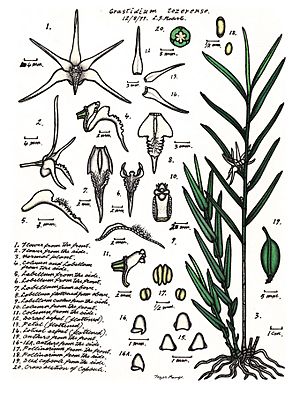White gemini orchid facts for kids
Quick facts for kids White gemini orchid |
|
|---|---|
 |
|
| Illustration by Lewis Roberts | |
| Scientific classification | |
| Genus: |
Dendrobium
|
| Species: |
tozerense
|
| Synonyms | |
|
Grastidium tozerense (Lavarack) M.A.Clem. & D.L.Jones |
|
The white gemini orchid, also known as Dendrobium tozerense, is a beautiful plant that belongs to the orchid family. It's special because it can grow on other plants (called an epiphyte) or on rocks (called a lithophyte), instead of just in soil! This orchid has thin, wiry stems, stiff leaves, and pretty white, star-shaped flowers that grow in pairs. You can find it growing in the rainforests of tropical North Queensland, Australia.
Contents
What the White Gemini Orchid Looks Like
The white gemini orchid is a type of herb that grows on other plants or rocks. It has many thin, wiry stems that can be between 20 and 60 centimeters (about 8 to 24 inches) long. These stems are only about 2 millimeters (less than an inch) wide.
Its light green leaves are spread out along the stems. They are long and narrow, shaped like a spear, and measure about 5 to 8 centimeters (2 to 3 inches) long and 6 to 8 millimeters (about 0.2 to 0.3 inches) wide.
The Orchid's Flowers
The flowers of the white gemini orchid are white and grow in pairs where the leaves meet the stem. They are star-shaped and measure about 3 to 3.5 centimeters (1.2 to 1.4 inches) long and wide. Orchid flowers have special parts:
- The dorsal sepal (the top part) is about 2 to 2.5 centimeters (0.8 to 1 inch) long.
- The lateral sepals (the side parts) are about 1.4 to 1.8 centimeters (0.5 to 0.7 inches) long.
- The petals are thin and pointed, about 1.2 to 1.5 centimeters (0.5 to 0.6 inches) long.
The labellum is a special lip-like part of the flower. It's about 7 to 10 millimeters (0.3 to 0.4 inches) long and has three parts, or lobes. The side lobes stand up, and the middle lobe has a blunt tip with crinkled edges. This orchid can bloom at different times throughout the year.
How the White Gemini Orchid Got Its Name
The Dendrobium tozerense was officially described for the first time in 1977. A botanist named Bill Lavarack found a sample of the plant at a place called Tozer's Gap on the Cape York Peninsula. He then wrote about it in a science journal called Austrobaileya. This is how the orchid got its scientific name, which includes "tozerense" after the place where it was found.
Where the White Gemini Orchid Lives
You can find the white gemini orchid growing on trees and rocks in rainforests. It also likes to grow on cliffs near waterfalls. Its home range stretches from some of the Torres Strait Islands down the Cape York Peninsula to areas like the Iron Range and Tully in Queensland, Australia.

